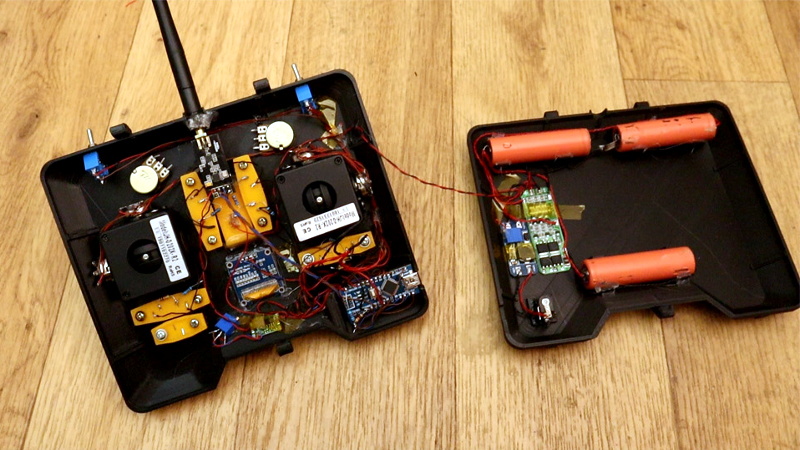It’s wasn’t so long ago that RC transmitters, at least ones worth owning, were expensive pieces of gear. Even more recently than that, the idea of an RC transmitter running an open source firmware would have been considered a pipe dream. Yet today buying cheap imported transmitters and flashing a community developed firmware (if it didn’t come with it pre-installed to begin with) is common place. It’s not much of a stretch to say we’re currently in the “Golden Age” of hobby RC transmitters.
But what if even cheap hardware running customizable software isn’t enough? What if you want to take it to the next level? In that case, [Electronoobs] has an Arduino powered RC transmitter with your name on it. But this is no scrap of protoboard with a couple of cheap joysticks on it, though he has made one of those too. The goal of this build was for it to look and perform as professional as possible while remaining within the hobbyist’s capabilities. The final product probably won’t be winning any design awards, but it’s still an impressive demonstration of what the individual hacker and maker can pull off today with the incredible technology we have access to.
 So what goes into this homebrew radio control system? Inside the back panel [Electronoobs] mounted the batteries, charging module, and the voltage regulator which steps the battery voltage down to the 3.3 V required to drive the rest of the transmitter’s electronics. On the flip side there’s an Arduino Nano, an NRF24 module, and an OLED display. Finally we have an assortment of switches, buttons, potentiometers, and two very nice looking JH-D202X-R2 joysticks for user input.
So what goes into this homebrew radio control system? Inside the back panel [Electronoobs] mounted the batteries, charging module, and the voltage regulator which steps the battery voltage down to the 3.3 V required to drive the rest of the transmitter’s electronics. On the flip side there’s an Arduino Nano, an NRF24 module, and an OLED display. Finally we have an assortment of switches, buttons, potentiometers, and two very nice looking JH-D202X-R2 joysticks for user input.
As you might have guessed, building your own transmitter means building your own receiver as well. Unfortunately you won’t be able to bind your existing RC vehicles to this radio, but since the receiver side is no more complicated than another Arduino Nano and NRF24 module, it shouldn’t be hard to adapt them if you were so inclined.
Low-cost consumer RC transmitters can be something of a mixed bag. There are some surprisingly decent options out there, but it’s not a huge surprise that hackers are interested in just spinning up their own versions either.

















Awww…
Awwww..
you beat me to it.
Well done.
If you want to connect to commercial RC receivers, projects have already been developed to do so. The place to check it out is: https://www.rcgroups.com/diy-electronics-199/
Nice project. Nrf24 arduino and 3d printed case, great combination. I would be cool to see some automatic binding in lieu of the nrf24 pipe, similar to openlrsng.
Nice, but I would use a lora32 module instead. Gives you a whole lot more range on 915Mhz!
Useful project. what about using one of the old Bluetooth headphones containing a generic module as an alternative to nRF24? Plus some use a little blue chip antenna which can be repurposed.
Incidentally the peak RF power with these emanates near the positive end so it can be mounted on a board on its end with + facing 45 degrees and then soldered in place very carefully as they degrade significantly if reflowed more than once.
yes they also work fine in transmit mode though not with a lot of power.
Measured using that old Wifi scanner board with a 3D glasses battery at >4 bars signal 12″ away.
It would be better it the DC jack would be either on the top or on the bottom of the enclosure, but not on the backside. With the current setup, you cannot lay down the remote while charging.
It´s a fine Project. I will use this in my quadrocopter project. What will yor do with the potentiometers.
If I’ve all components, it is possible to have the software?
what about RSSI ?
so where is channel mixing option